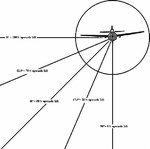A
Anonymous
Guest
Well, it is obvious, it wll slide to the right. But that does not mean it has no lift.
On the F4U there is an equal and opposite force created by the other wing, which is bent in the other direction.
The loss of lift from the wing angle is as I've shown. If you like, we can contact an expert to confirm it
On the F4U there is an equal and opposite force created by the other wing, which is bent in the other direction.
The loss of lift from the wing angle is as I've shown. If you like, we can contact an expert to confirm it

